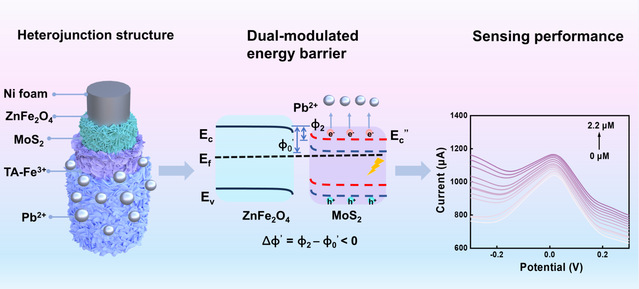Recently, Professor Zhao Minggang's team from the College of Materials Science and Engineering at Ocean University of China has made new progress in the field of high-performance anti-interference electrochemical and optical sensing research. The related achievements were respectively published in the internationally renowned academic journals Advanced Functional Materials, Chemical Engineering Journal and Nano Letters.
With the advancement of the country's Maritime Power construction, establishing a real-time online monitoring system for Marine pollutants has become a major demand. However, due to the high salinity, complex background ions and variable environmental conditions in seawater, traditional sensors often find it difficult to achieve accurate detection. This leads to significant deficiencies in the selectivity and anti-interference ability of the existing electrochemical sensors. In response to this challenge, the research team innovatively designed a highly anti-interference sensing interface based on TiO₂/ UiO-67S type heterojunction band engineering. This interface uses physical gating as the trigger factor to precisely regulate the band alignment of the heterojunction, significantly enhancing the specificity of phosphate detection. Mechanically, the adjustable contact barrier of the S-shaped heterojunction not only optimizes the interfacial energy level structure but also promotes the efficient separation of photogenerated carriers, achieving a strong specific response to phosphate ions in the complex background of seawater. Experiments show that the detection limit of this sensor for phosphate is as low as 43 pM, and it maintains signal stability under the coexistence of interference ions with a concentration of ten thousand times. This research provides a new solution for developing highly reliable Marine environment monitoring technologies. The relevant paper is titled Band Alignment in TiO₂/UiO-67 S-Scheme Heterojunction for Anti-Interference Phosphate. Sensing (Research on Band Alignment of TiO₂/ UiO-67S Heterojunction for High Anti-Interference Phosphate Sensing) was published in the top journal in the field of Materials, Advanced Functional Materials. The first author of this paper is Guo Rong, a doctoral student from the School of Materials Science and Engineering.

Figure 1 Schematic diagram of the preparation of physically gated S-type heterojunctions and their phosphate sensing mechanism
Meanwhile, the research group proposed a photoelectric and electrostatic synergistic strategy to construct a dual-modulation energy barrier to achieve specific capture and detection of lead ions. This strategy employs the ZnFe2O4/MoS2@TA-Fe3+ dual-driven heterojunction sensing interface, which triggers electrostatic field reconstruction through the directional migration of photogenerated carriers and the specific adsorption of Pb²⁺. Dynamic energy barriers precisely avoid REDOX competitive reactions; Simultaneously screen out high-concentration interfering ions. Experiments show that the sensitivity of this sensor to Pb²⁺ is as high as 80.5 μA μM-1 cm-2, and lead detection at 37 nM is achieved in actual seawater samples. This research provides a breakthrough technical solution for on-site monitoring of Marine heavy metal pollution. The relevant paper is titled Anti-interference detection of Pb (II) in seawater enabled by a photo-electrostatic ZnFe2O4/MoS2 heterojunction. electrode (Anti-interference Detection of lead (II) in Seawater Using Photoelectrostatic ZnFe2O4/MoS2 heterojunction electrode) was published in the top Journal Chemical Engineering Journal in the field of chemical engineering. The first author of this paper is Huo Shu, a master's student from the School of Materials Science and Engineering.

Figure 2. Structure of ZnFe2O4/MoS2 heterojunction and principle of photoelectrostatic synergistic sensing
In addition, the research group proposed a new three-dimensional self-assembly method for precious metal nanoparticles for the detection of Marine pollutants. Functionalized nanoparticles were self-assembled into centimeter-sized large-area bilayer metasurface at the three-dimensional liquid-liquid interface, which exhibited significant multimodal surface plasmon resonance effects and surface-enhanced Raman scattering effects optically. Innovatively, by constructing a sandwich structure, Encapsulate various Marine microplastics to be tested (such as PS, PET, PMMA, etc.) and small molecules (such as melamine, cysteine, iminothiourea, etc.) within it, which not only significantly enhances the detection limit but also avoids the influence of the coffee ring effect on the uniformity and repeatability of the detection. The relevant paper is titled 3D Self-Assembly of a Bilayer Nanoparticle Metasurface for Surface Enhanced Raman Scattering (SERS) The paper titled Sensing (Three-dimensional Double-layer Self-assembled metasurface of Nanoparticles for SERS Sensing) was published in Nano Letters, a top journal in the field of materials science. The first author of this paper is Zhao Mingfu, a master's student from the School of Materials Science and Engineering.

Figure 3 Schematic diagram of a three-dimensional bilayer self-assembled metasurface of nanoparticles for the detection of seawater microplastics and small molecules
Ocean University of China is the first corresponding institution of the above paper, and Professor Zhao Minggang and Associate Professor Ma Ye from the School of Materials Science and Engineering of Ocean University of China are the corresponding authors. This research was supported by the National Natural Science Foundation of China (Grant No. 52072353) and the Key Core Technology Special Project of the Basic Scientific Research Business Expenses of Ocean University of China (Grant No. 202562002).
The original link: https://doi.org/10.1002/adfm.202519552
https://doi.org/10.1016/j.cej.2025.169884
https://doi.org/10.1021/acs.nanolett.5c01327
Text and Figures by Guo Rong


